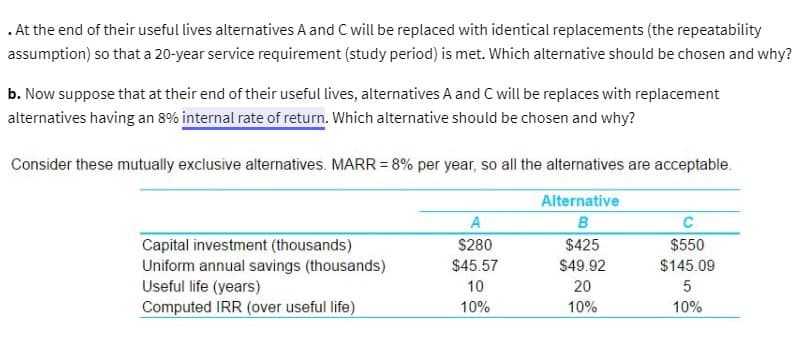. At the end of their useful lives alternatives A and C will be replaced with identical replacements (the repeatability assumption) so that a 20-year service requirement (study period) is met. Which alternative should be chosen and why b. Now suppose that at their end of their useful lives, alternatives A and C will be replaces with replacement alternatives having an 8% internal rate of return. Which alternative should be chosen and why? Consider these mutually exclusive alternatives. MARR = 8% per year, so all the alternatives are acceptable. Alternative B $425 $49.92 Capital investment (thousands) Uniform annual savings (thousands) Useful life (years) Computed IRR (over useful life) A $280 $45.57 10 10% 20 10% $550 $145.09 5 10%
. At the end of their useful lives alternatives A and C will be replaced with identical replacements (the repeatability assumption) so that a 20-year service requirement (study period) is met. Which alternative should be chosen and why b. Now suppose that at their end of their useful lives, alternatives A and C will be replaces with replacement alternatives having an 8% internal rate of return. Which alternative should be chosen and why? Consider these mutually exclusive alternatives. MARR = 8% per year, so all the alternatives are acceptable. Alternative B $425 $49.92 Capital investment (thousands) Uniform annual savings (thousands) Useful life (years) Computed IRR (over useful life) A $280 $45.57 10 10% 20 10% $550 $145.09 5 10%
Managerial Economics: A Problem Solving Approach
5th Edition
ISBN:9781337106665
Author:Luke M. Froeb, Brian T. McCann, Michael R. Ward, Mike Shor
Publisher:Luke M. Froeb, Brian T. McCann, Michael R. Ward, Mike Shor
Chapter5: Investment Decisions: Look Ahead And Reason Back
Section: Chapter Questions
Problem 5.4IP
Related questions
Question

Transcribed Image Text:. At the end of their useful lives alternatives A and C will be replaced with identical replacements (the repeatability
assumption) so that a 20-year service requirement (study period) is met. Which alternative should be chosen and why?
b. Now suppose that at their end of their useful lives, alternatives A and C will be replaces with replacement
alternatives having an 8% internal rate of return. Which alternative should be chosen and why?
Consider these mutually exclusive alternatives. MARR = 8% per year, so all the alternatives are acceptable.
Alternative
B
Capital investment (thousands)
Uniform annual savings (thousands)
Useful life (years)
Computed IRR (over useful life)
A
$280
$45.57
10
10%
$425
$49.92
20
10%
C
$550
$145.09
5
10%
Expert Solution
This question has been solved!
Explore an expertly crafted, step-by-step solution for a thorough understanding of key concepts.
Step by step
Solved in 3 steps

Knowledge Booster
Learn more about
Need a deep-dive on the concept behind this application? Look no further. Learn more about this topic, economics and related others by exploring similar questions and additional content below.Recommended textbooks for you

Managerial Economics: A Problem Solving Approach
Economics
ISBN:
9781337106665
Author:
Luke M. Froeb, Brian T. McCann, Michael R. Ward, Mike Shor
Publisher:
Cengage Learning

Managerial Economics: A Problem Solving Approach
Economics
ISBN:
9781337106665
Author:
Luke M. Froeb, Brian T. McCann, Michael R. Ward, Mike Shor
Publisher:
Cengage Learning